Graham Connor
(16th January 1957 – 26th December 2018)
A life in SF and space
We recently lost one
of SF² Concatenation's founding editors who
led a remarkable life encompassing science, SF and space.
We remember him here.
Graham was born in the Cumbrian, coastal town of Workington, in the shadow of Windscale (now Sellafield). 1957 was the year of the Windscale nuclear disaster. And so the scene was set for Graham to potentially have been bitten by a radioactive spider and become a superhero. But, alas, that did not happen.
Workington itself was not the most prosperous part of Britain. There was only one major employer and that was British Nuclear Fuels (BNFL) at the Windscale nuclear plant: BNFL dominated the community; virtually touching every local either directly or indirectly. So perhaps it was not too surprising that at his local school Graham took to science and physics.
|
 Inmarssat.
Inmarssat.Above and below, two of the many satellites on which Graham worked, as are all the satellites pictured within this article
 Eutelsat.
Eutelsat. |
His youth also saw him start reading science fiction and fantasy and the beginning of a lifelong passion.
And so, one thing led to another and soon it was 1975 and Graham was studying physics at Warwick University. Graham enjoyed his course greatly but, it has to be said, found the notion of actually going to lectures rather boring. By the time he successfully completed his first and second years – passing his exams with no problems – he really had had enough of lectures and so in his final year hardly ever went to them. This came back to hit him regarding his degree qualification, when Graham was bluntly told that 'we do not give Firsts to students who rarely turn up to their lectures' (even though some might say that that was all the more a reason as to why he truly deserved one).
© All satellite images on this page are copyright either ESA or NASA and used under their respective non-commercial use policy. Click on the afore links for their respective copyright policies.
|
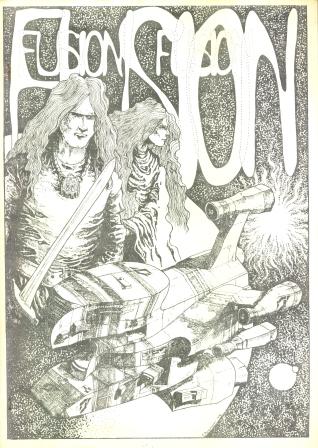 Warwick University SF Society's 1978 edition of its fanzine Fusion that was edited by Graham.
Warwick University SF Society's 1978 edition of its fanzine Fusion that was edited by Graham. |
However, at the university, Graham also found other attractions, including its Science Fiction and Fantasy Society. It was, in 1976, that Graham went to his first SF convention, Novacon. Then, in his final year, Graham produced Warwick University SF Society's annual fanzine, Fusion.
Alas, without a First Class Honours degree, Graham could not do what he really wanted to. What he really wanted was a tenured research position at a major, international physics facility to study gravity. Had his career gone down this path who knows where it might have led? The detection of gravity waves? Probably. The development of loop quantum gravity theory? Possibly. Invent Cavorite? Well, we would like to think so.
Instead, without a First Class degree, Graham was forced back to another area of science – space satellite communications.
|
 Orion 3.1
Orion 3.1
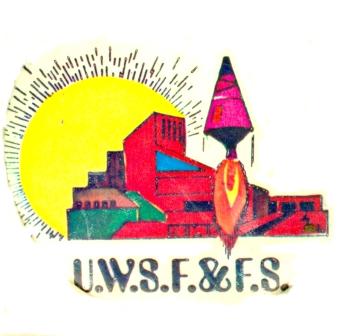  Warwick U. SF Society (to which Graham belonged as an undergraduate) logo consisting of the 'cone' sculpture outside the Art Centre taking off as a rocket. And the Hatfield PSIFA (of which Graham was an active external member) consisting of a fantasy dragon riding an SFnal saucer.
Warwick U. SF Society (to which Graham belonged as an undergraduate) logo consisting of the 'cone' sculpture outside the Art Centre taking off as a rocket. And the Hatfield PSIFA (of which Graham was an active external member) consisting of a fantasy dragon riding an SFnal saucer. |
Okay, so this was not 'rocket science' (well it sort of was) but it did have an SF connection what with the idea of global communications via a network of geostationary satellites originating from a well-known SF author. There was nothing for it: in 1978 Graham went job hunting. This soon ended up with an interview at Marconi Space and Defence Systems in Stanmore. This was not far from Hatfield and its college's (Hatfield Polytechnic now called Hertfordshire University) SF society PSIFA. The bottom line is that Graham got the job and so stayed in the area in an employer-owned flat-share in Bushey. This also enabled him to participate in Hatfield PSIFA activities.
Through PSIFA Graham met many people, including two who had a flat in Radlett. So in 1979/80 when Marconi kicked Graham out of their accommodation (the firm's policy was that accommodation was for short-term use only), Graham moved in with his Hatfield PSIFA Radlett friends.
|
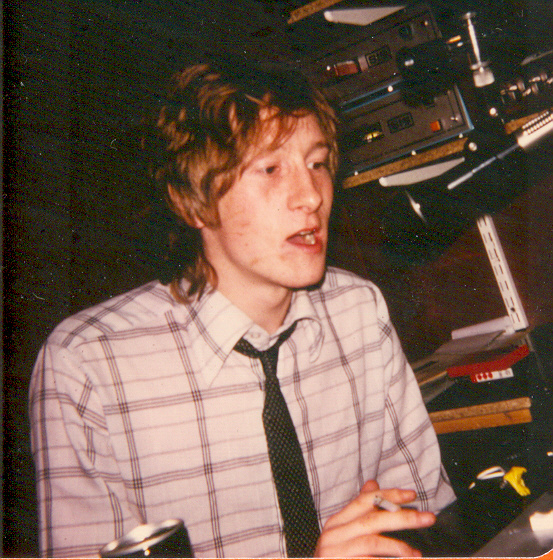 Graham (1979), broadcasting as Jededia Cortex in the Radio Free Entropy show for Campus Radio Hatfield.
Graham (1979), broadcasting as Jededia Cortex in the Radio Free Entropy show for Campus Radio Hatfield.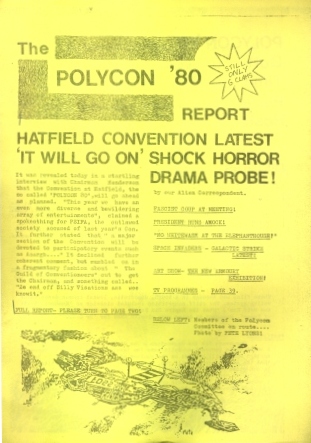 The cover of Progress Report 2 for Shoestringcon 2 designed by Graham.
The cover of Progress Report 2 for Shoestringcon 2 designed by Graham. |
Graham took an active part in PSIFA activities in many ways including – with Jonathan Cowie and Dave Lermit – running its SF radio show – called Radio Free Entropy – on the college's Campus Radio Hatfield.
The premise behind the Radio Free Entropy show was that three aliens had taken over one of the Salyut space stations in order to beam 'cultural' information to Earth's primitive habitants. As one of the show's 'alien' presenters, Graham took on the alias Jededia Cortex. The show consisted SF-themed music, pre-recorded interviews with SF and fantasy authors and news-ish reviews from SF conventions. Of note Kenny Everett kindly gave permission to broadcast, and even provided a set of tapes of, the adventures of Captain Kremmen.
Another contribution Graham made to Hatfield PSIFA activities was his being on the committee (along with his Radlett flatmates) of PSIFA's second 'Shoestringcon' SF convention. (The name 'Shoestringcon' was a cunning ploy to set the bar so low that the student events would not engender opprobrium with the broader British science fiction community at large that had just hosted a World SF Convention [Worldcon] the previous year.) Graham's role on the committee was to produce the pre-convention, publicity 'Progress Reports'. Today such a task would, in addition to a way with words, require a basic knowledge of world processing and layout.
|
|
|
However, this was 1980. There was no desktop publishing, let alone home desktop publishing: there were no home computers. Office-level publications were back then done by Gestetner duplicators or, if you were very lucky – and PSIFA was with its students' Union – a small offset litho. Nonetheless, even with this last, layout was done by sticking blocks of typewriter written text and artwork onto homemade layout board. Graham took to this with some gusto and even produced justified text without the use of a word processor by counting up the numbers of letters and spaces in a line of typewriter-written text and then using that same number for the next line. It was a painstaking task that took the best part of an afternoon to produce the layout for a single page! It has to be said that the quality of Graham's layouts somewhat exceeded that of the reprographic quality: Graham again pushing technology to its limits.
|
|
Shoestringcon 2's Guests of Honour were the author Ian Watson and the team behind the 2000AD comic. The latter must have enjoyed the Hatfield SF convention that Graham helped organise, for 2000AD subsequently included a number of references to Hatfield PSIFA including a Mega-City One PSIFA block in Judge Dredd as well as a thinly-disguised reference to the Hatfield conventions in a Tharg story in the 1983 2000AD annual. Splundig.
|
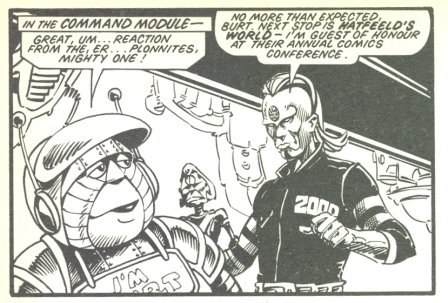 From the 2000AD 1983 annual (1982).
From the 2000AD 1983 annual (1982). |
 NileSat.
NileSat.
 SkyNet 5.
SkyNet 5. |
Meanwhile, Graham continued attending science fiction conventions, including British Eastercons and Brit-venued Worldcons and Eurocons. One non-British Worldcon he did attend was the 1990 held in the Hague, The Netherlands. This was vaguely prescient as Graham – as we shall see – Graham was to return to the Netherlands a few years later to work.
For those in the SF community that knew him, it was unnerving, to some that knew Graham, that one of the satellites he worked on was called Skynet 4.5. Was it simply coincidence that Sarah Connor and Graham shared the same surname?
Graham always thought that SF fandom was something of a metaphor for life with its ups and downs. He would often say that a convention was like being presented with a splendid feast except that someone had smashed glass amongst it. However, pick diligently between the fragments and you could have your fill.
|
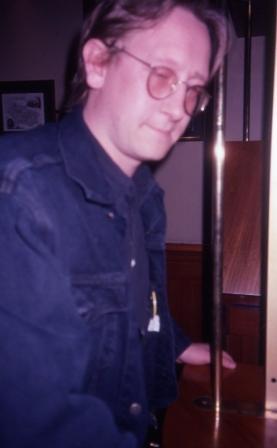 Graham at the 1993 SF Eurocon, Jersey.
Graham at the 1993 SF Eurocon, Jersey.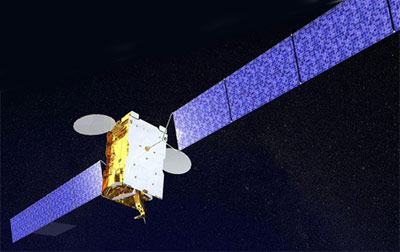 Hot Bird 8.1
Hot Bird 8.1 |
Graham also helped out at SF conventions including being one of the film projectionists at the BECCON series of conventions and even being on the organising committee of the aforementioned second of Hatfield PSIFA Shoestringcons.
It should be noted that Graham was quite a reader of science fiction. Among his favourite authors were: Cordwainer Smith, Alfred (working class) Bester (an American writer whom Graham actually got to meet) and Philip K. Dick. With this last in mind, you will not be surprised that his favourite SF film was Blade Runner. He was also into 2000AD (he even met its editorial team a couple of times including at the aforementioned Shoestringcon he helped organise) and Judge Dredd as well as the television shows Babylon V and Red Dwarf.
Meanwhile Graham was developing his expertise in microwave satellite communications. (This article's illustrations include pictures of just a few of the satellites on which Graham worked.) He moved to British Aerospace. There he worked on the program STEPS which solved Maxwell’s equations for rectangular, cross-section waveguides. Using Graham’s program, British Aerospace was the first company in Europe (and probably the world) to develop waveguide diplexers requiring no tuning screws: as you may very well know, these have big advantages for high-power handling. Even today, British Aerospace (now called Airbus) are still leaders in the field.
|
 ESA's Artemis.
ESA's Artemis.
 SF² Concatenation issue no. 3.
SF² Concatenation issue no. 3.
Graham was a founding co-editor of SF² Concatenation but specifically was the issue editor for its 1989 #3 edition. |
In his personal life, he met and married the animation cartoon artist Bridget. And he even occasionally helped her with her work when deadlines were pressing; which is how come he contributed to Paul McCartney's 'The Frog Song'. Despite a couple of very enjoyable years, for one reason or another, this relationship was not built to last, and the two went their separate ways.
Graham's way was to take him to Arlesey where he began to lay down roots.
Meanwhile, a little earlier in the late 1980s, Graham, with a couple of friends, created and edited the annual science and SF review SF² Concatenation..
For the next several years, there was something of a regular pattern to producing the fanzine. Material was written by the editors, as well as solicited from others together with advertising, throughout the year. Then Graham and the other editors would have a layout session (using scissors, rulers, copious amounts of snow pak and spray mount) in the days following each Christmas. This was completed before New Year which was itself celebrated with nearby friends who also were loosely connected with the publication. Distribution took place at the British national SF convention at Easter.
SF² Concatenation ran for nearly a decade as a print magazine before lapsing in the late 1990s.
|
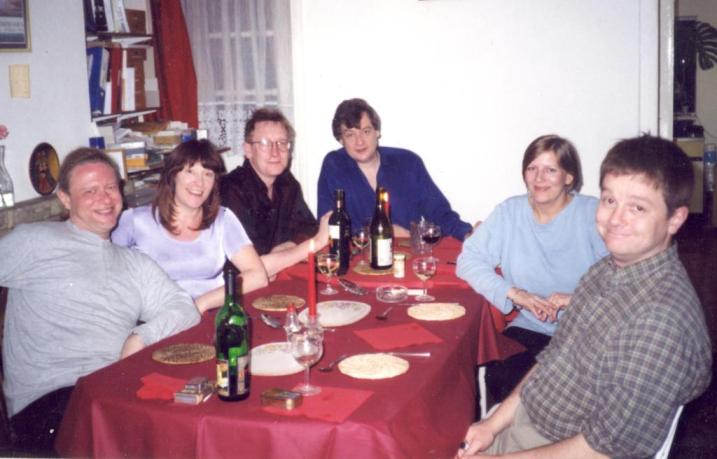 Graham and SF² Concatenation-related friends in the 2000s. Tony C., Donna, Graham, Jonathan, Elaine and Simon.
Graham and SF² Concatenation-related friends in the 2000s. Tony C., Donna, Graham, Jonathan, Elaine and Simon. |
But Graham would not let it rest and kept banging on about how we should create an online archive using this wonderful (then relatively) new thing called the internet. And so, to cut a long story short, Concatenation.org came into being.
What also continued was the socialising that had been associated with the layout sessions. These included dinners where discussion often covered the latest developments in physics and biology, not to mention banter as to the merits of the two disciplines that decades later, today, might be somewhat reminiscent of that between Amy Farrah Fowler and Sheldon Cooper.
|
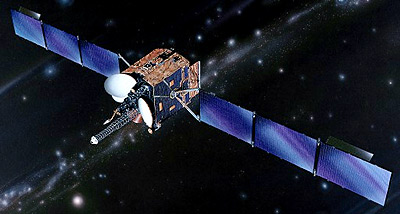 Skynet 4.1
Skynet 4.1 |
The 1990s saw Graham have a two-year stint at ESTEC (the European Space Agency's – ESA's) technology centre in Noordwijk, The Netherlands). Aside from him playing football as part of the ESTEC staff team – sponsored by his local pub, The Harbour Lights – there are two stories from this time that perhaps reflect Graham's character.
|
|
|
The first concerns Graham's appreciation of government/state funding and that this should not be wasted! Graham was appalled by the instances of money-squander be it a brand new, but unused, multi-storey building for a project that was cancelled, or that tenured ESA staff flew expensive first class. Why?
The second concerns Graham's no nonsense 'what-you-see-is-what-you-get' approach. At ESA, Graham often wore jeans and no tie. All well and good: what people wanted was Graham's physics expertise, not his fashion sense. (Having said that, some like to think that it was Graham who started the current vogue for torn jeans. A few may think otherwise, but they may be wrong.)
Meanwhile, back at the plot, a Japanese aerospace industrial representative was paying ESTEC a visit for technical guidance. The thing was – and how can this be said in these, oh so politically correct days? – the Japanese have a strict sense of etiquette. And so, on arrival the Japanese visitor gave everyone on the team a present. Graham thought nothing more of it, except that after a week or so the visitor began to realise that at meetings everyone else was listening to what scruffy Graham said and then act upon his words. The Japanese representative sussed what was going on. He went up to Graham, profusely apologising, asking for his gift back, explaining that he had been given the wrong one and he should have this other present, one more appropriate to Graham's actual role and status on the team, instead.
|
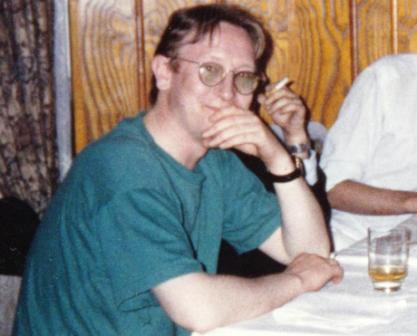 Graham, Timisoara Eurocon, 1994.
Graham, Timisoara Eurocon, 1994. |
Graham eventually returned to Britain and, again long story short, ended up at Astrium in Stevenage (hence his aforementioned move to nearby Arlesey). There he continued to design key communication components for satellites.
Meanwhile, Graham's brother in Kent was not well and so Graham regularly began to visit. It was during this time he met Donna, and in 2002 the two got married to live in Arlesey.
Sadly, Graham's brother passed away.
|
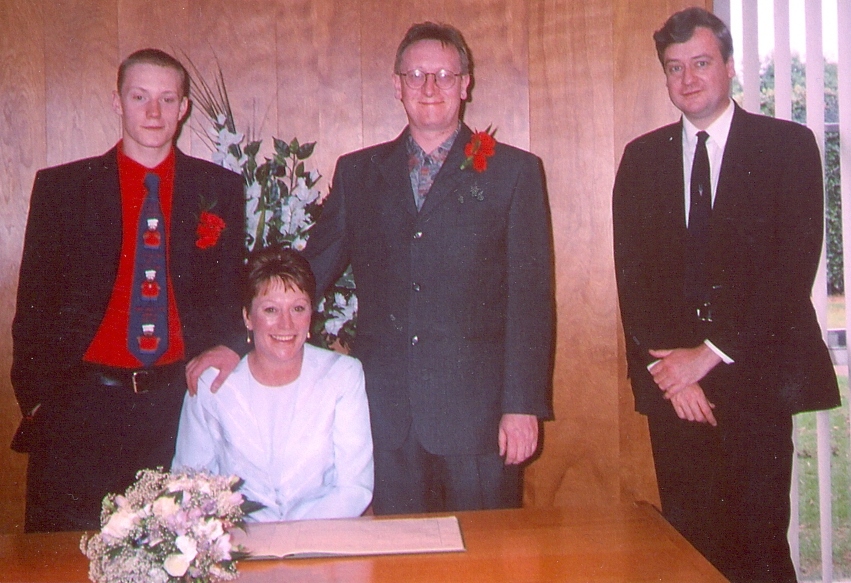 12th July 2002.
12th July 2002. |
Yet Graham's new family, with Donna and stepson Tim, his work in aerospace and his interest in science fiction kept him going.
There are too many tales that could be told of Graham, let alone of his years with Donna, but alas there is not now the time. So no space here to tell you how, when once the two were on holiday and Graham was water-skiing, Graham accidentally gave himself an enema.
|
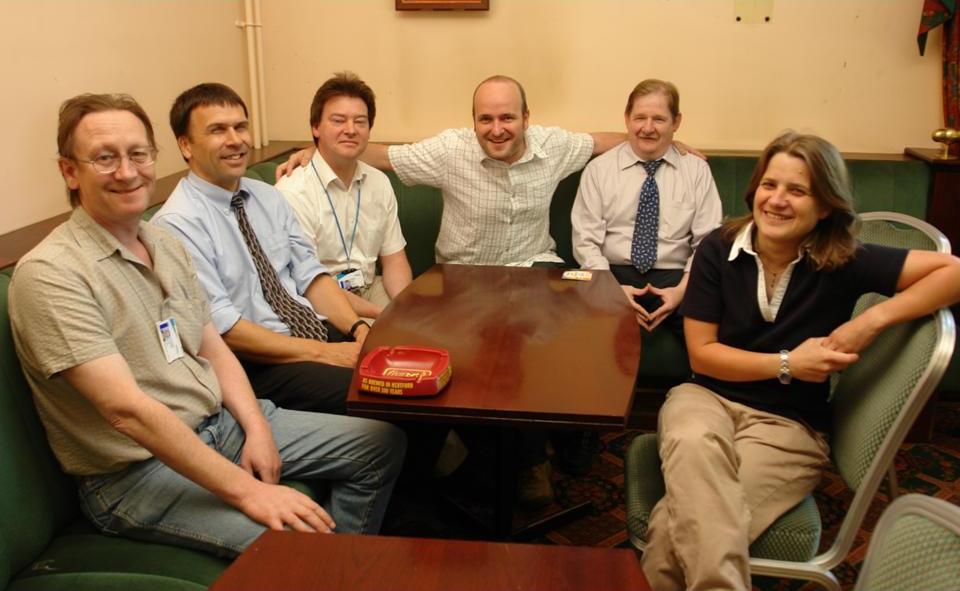 Graham and workmates: Larry, Boothy, Mark, Skeeno, and Sonya (2006).
Graham and workmates: Larry, Boothy, Mark, Skeeno, and Sonya (2006).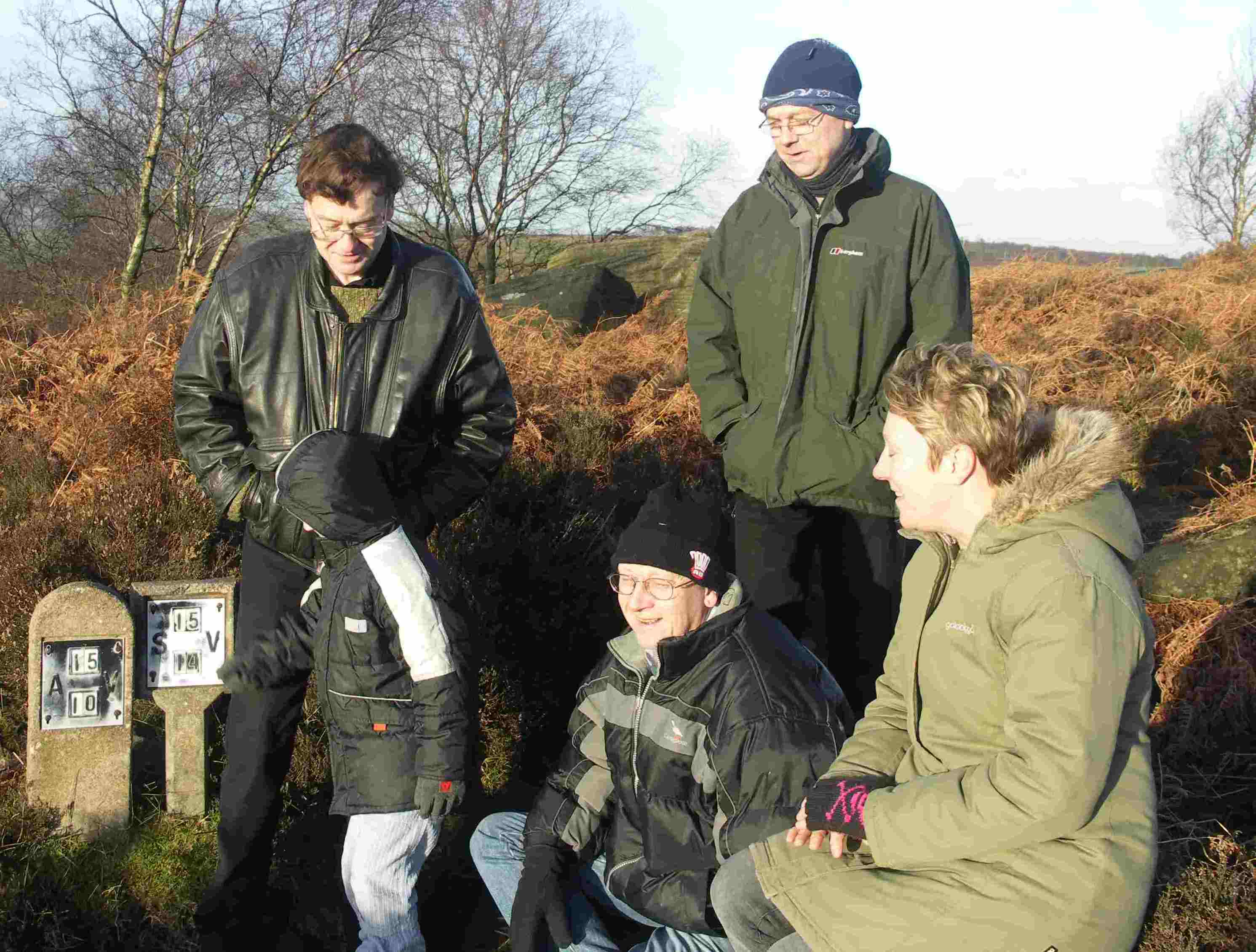 Peak district with little Luke, Jonathan, Simon, Donna and Graham (2007).
Peak district with little Luke, Jonathan, Simon, Donna and Graham (2007).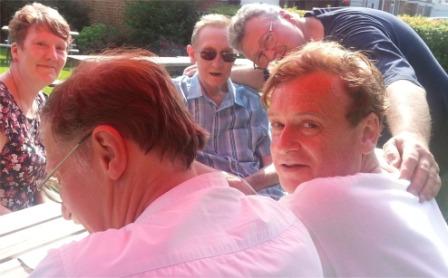 Donna and Graham with Old Age PSIFAns: John W, Jonathan C. and Anthony H. (2014)
Donna and Graham with Old Age PSIFAns: John W, Jonathan C. and Anthony H. (2014) |
Life was becoming rather good when in 2008 Graham had a brain haemorrhage. This tragically halted his career as well as his science fiction activities.
Nonetheless, if Graham could not go to SF conventions then conventions would come to Graham. So for the past few years there have been occasional SF pub gatherings in Arlesey, first with fellow PSIFAns and later with former BECCON organisers.
Graham also enjoyed visits from his former, Stevenage work colleagues. Together, these meets were something of a lifeline.
Despite much loving care from Donna, matters in health terms thereafter took a slow, inevitable trajectory. His family, friends (including all of us at the SF² Concatenation), work colleagues, have had the benefit of being able to share part of our time with, as well as have companionship of, a remarkable and talented soul. We miss him.
The above is based on the eulogy for Graham given by Jonathan Cowie on 11th January 2019.
Below are some tributes from those close to Graham.
|
|
|
Tributes
Anthony Heathcote
I first met Graham about 40 years ago — half a life-time — at the Hatfield Polytechnic Science Fiction Society, PSFIA. Graham had moved down from Warwick some months earlier and was settling into a new life in Hertfordshire. A few months later a vacancy became available in the maisonette in Radlett, I was sharing with John Watkinson and with help from our mutual friend, Jonathan, Graham moved in.
We spent several happy years together there with many sessions to the village pub, our annual riotous summer parties and even a mammoth SF book auction over a long weekend. And then was the regular SF Conventions with our wider group of friends all over the country.
Two anecdotes spring to mind: One day a sizable brown parcel arrived for Graham. It was a book — Gravitation Theory — Graham was absorbed by it; it was all very cool. So the morning conversations often started along the lines of “I see Gravity’s still working then...”
Graham suggested we should go to see an unknown poet playing in St Alban’s: John Cooper Clark. As he blasted his poetry I spotted alone girl in the shadows of the hall and attempted a conversation with her. Later that evening while travel back to Radlett, who should get on and sit opposite us but John Cooper Clarke and the said girl. It was his then girl-friend and flat mate. Many year later with a bit of research on the internet, Graham realised this was most likely Nico, who’d carved a bit of a name for herself in the late 1970’s in the New York underground art and music scene. I’m not so sure but Graham was convinced. Graham would always relate this tale to anyone who’d lend an ear. I’m sure Graham’s smiling now.
Eventually as we grew older, but no necessarily wiser, we all move on our separate ways.
Graham’s devastating and tragic stroke shocked us all but with the help, care and love of Donna, they built a new life together. In recent years, I along with John Watkinson and Jonathan have made an annual trip to see Graham and Donna and to take them out to the village pub. The sun always shone. I’ll miss these trips. So long fella, miss you.
John Watkinson
Anthony has mentioned how he and I first met Graham. Much of our time together in Radlett involved drinking vast quantities of ale, and playing pub games. Then Graham decided to get a motorbike, and with a further PSIFA friend Peter Gilligan, (sadly also now deceased) the three of us would go for a burn up and an inevitable pint or two afterwards.
Unfortunately, I lost touch with Graham after I got married and set up home away from Radlett. Many years passed and then the news came from Jon that Graham’s life had been changed terribly by a stroke. For me it became a time to catch up with him and to meet Donna at those summer visits to Arlesey with Jon and Anthony. Graham always liked a good natter and his anecdotes always made us smile. Rest in peace old friend, but as you were never one to rest on your laurels; I expect you are quite busy discussing with God how gravity could be improved in his next great project.
Simon & Elaine
We first met Graham through Jonathan at Christmas during one of the Concatenation fanzine layout sessions. It became a regular event to catch up with Grai whenever he came to visit and for a good few years we spent much of Christmas and New Year celebrations together.
There are so many good memories. Conversations that lasted for years with many long evenings discussing: gravity and trying -- very unsuccessfully -- to work out the basics of the physics of faster than light communications; Simon and Jonathan trying to ‘help’ Graham, a mere physicist, to understand the complexities of biology and landscape ecology; and the shared enjoyment of Blade Runner, Iain M. Banks books and Babylon 5 - ‘cos the space ships flew properly.
The unforgettable millennium year 2000 and the New Year's celebration with Graham and Donna is one of our fondest memories. A lovely evening of chat and laughs ending up in our back garden watching the amazing spectacle of the fireworks lighting the sky up across London for what seemed like hours.
We are immensely sad to have lost Graham from the world. Our love and thoughts are with Donna.
Emma
Graham wasn't just "my friend Donna's Husband", he
was my friend too.
He was always ready with a joke when he knew I was
coming round, and would make one up if i turned up
unexpectedly. One particular joke has always stuck in
my mind, being this:-
"Jerry lost his eye in an accident and couldn't afford the
price of a glass eye. So, he carved himself one out of
wood. But he was so self-conscious that he never left
the house.
Finally, his friend Ed came over and forced him to go
out. "There's a dance over at the club" he said. "So what
if one of your eyes is made out of wood?"
"Alright" said Jerry, "but if anyone makes fun of my eye,
then I'm leaving."
He went to the dance and stood around, trying to build
up his courage. And then he saw a woman standing
alone in the corner. She was very attractive, but she
had a wooden leg.
"She's worse off than me" Jerry thought. "The least I
can do is ask her for a dance."
He walked across the crowded dance floor and
approached the girl. "Would you care to dance?" he
enquired.
"Wouldn't I?!" she exclaimed.
"That does it," he shouted "bloody peg leg". (Although
"bloody" wasn't the word that Graham used)
Jokes aside, I have so many good times and memories
to thank Graham for. In short, Graham was clever,
funny, quirky, but most of all a lovely man.
Goodnight Graham, love from Emma & Family xx
From Tim and Bobby
'Tapes, Games and Videos'
Those tapes I found when I was 14 were the best
mistake,
Those tapes you left behind would be the music I would
make,
Those tapes I listened to was good music to my ears.
Those tapes you recorded will stay with me for years.
Those games we played gave hours of fun,
Those games you lent me were always the one.
Those games I conquered and you didn't complete,
Those games are forgotten but there was no defeat.
Those videos I borrowed were never returned,
Those videos you taped was much much more.
Those videos I watched from noon until night,
Those videos you forgot I kept them tight.
Donner Connor
I would like to share Judy A. Campbell's poem (2017) poem 'If I Forget To Tell You'.
If I forget to tell you, I had a wonderful time
For all the todays and tomorrows
And for the years we left behind.
If I forget to tell you, I love your calm
And gentle ways and how you never
Lose your cool, even on our troubled days.
And you tell me that you care for me more
Than you can ever say, and you love me more
Than anyone can on any given day.
And what about the silly things we laugh at
In the night, and how you always try your best
To make things work out right.
And you give me all I ever need, and you give
Me so much more, especially love from inside
Your heart that I fondly hold in store.
You shower me with treasures, the ones that
Money can't buy, and there are many times
You've protected me while walking by my side.
And how about the memories through these
Years we've shared and the blessings you bestow
Upon me; nothing can compare.
So to you these words I've written from my heart
Are true; someday I'll write a few more lines and
Add a page or two
Just in case I forget to tell you.
[ Originally posted: 25th April 2019 | Home ]
|
|





















